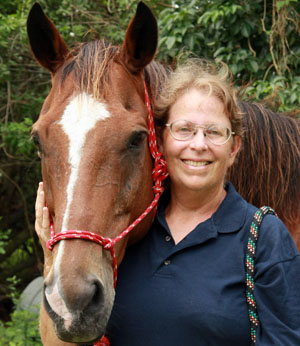TALES FROM THE TRAILS
Thursday, March 26 was the final installment of this year’s Lunch & Learn series at the Winter Equestrian Festival. While attendees enjoyed a fried chicken lunch, the learning part was a talk titled “Sound Year Round,” sponsored by Theraplate. The speaker was wonderfully down-to-earth, and what she had to say made a whole lot of sense.
Janus Marquis is the official equine physiotherapist for the United States show jumping team. She excels at preventing and treating injuries using therapeutic modalities such as lasers, ultrasound and stretching. She has accompanied the team to three Olympics: Athens 2004, Hong Kong 2008 and London 2012, as well as the 2010 World Equestrian Games in Lexington, Ky., and the 2011 Pan American Games in Guadalajara, Mexico.
Marquis lives in New Mexico, though she’s not there often. She travels with the team in Europe every summer and to the Winter Equestrian Festival in Wellington each winter. However, she finds time to help one or two rescues each year, especially off-track Thoroughbreds.
“They’re brilliant performance horses, intelligent, athletic and they’re bred to go forward,” she said. “They’re quiet, sensitive and have great hearts. They deserve to have second careers after they’re done racing. I have yet to be disappointed with them.”
Back to the Lunch & Learn lecture. Marquis’ first tip: Have your horse stretch before and after work.
“Carrot stretches are good,” she said, referring to using pieces of carrots to entice a horse into reaching back toward the girth on both sides, as well as down between the front legs. “It’s best to do them unsaddled, so the horse can move more freely.”
Backing up is a tremendous warm-up stretch, as long as it’s done correctly, Marquis said. “The horse’s head shouldn’t be up, because that hollows out the back. The head should be flexed down, which opens the back,” she explained.
She also warned about skin issues in South Florida’s steamy weather.
“One way to avoid some of them is to not hose off your horse as soon as you finish riding. It’s better if you wait until after the sweat has dried,” Marquis said. “When they’re sweating, the pores are wide open, making it easier for fungus and bacteria to invade. If the skin is cool and the pores have closed, there’s less chance of promoting skin problems. Preventing is always better than treating.”
Making sure your saddle fits and is properly placed can also make a world of difference.
“One interesting change I’ve found is encouraging people to use the second and third billet straps for the girth,” Marquis said. “Many people use the first and second, or first and third, but using the second and third levels of the saddle keeps it more balanced. And speaking of the girth, never girth up a horse too soon or too tightly. There’s a lot of cartilage around the sternum; it’s a fluid piece of anatomy. You should do up the girth in stages, never just crank it tight.”
Placing a well-fitting saddle is equally important, she added.
“Many riders want to move the saddle too far forward, where it interferes with the horse’s scapula,” Marquis said. “The shoulder blade has to be able to move freely up and back. You should let the saddle sit where it wants to sit naturally, not keep moving it forward.”
Marquis is a huge fan of massage therapy and encourages people to learn enough to do daily massages.
“You get to know your horse better and can observe any changes. Get your hands on your horse. Working with a soft plastic curry is a great way to aid circulation,” she said. “Get in there and work with it. You’ll do more than just remove dirt. Your horse will tell you where to go and how hard to push, especially the thin-skinned Thoroughbreds.”
Lasers have some therapeutic applications, Marquis noted. They can aid with skin problems and help cuts and lacerations heal faster. They’re also good for treating some muscle and joint injuries and induce more effective healing. Magnets can also help balance a horse’s body. But, mostly, she said, bodies are designed to heal themselves.
“These modalities help that process without getting in the way, as some drugs may,” Marquis said. “Acupuncture is fabulous, very effective. It can correct internal imbalances and treat performance-related issues. It’s a great complement to traditional medicine.”
Simple things to do to make your horse happy and healthy: turn him out on a regular basis, vary your training program to include trail rides, and let horses be horses. “Listen to your horse. They’re the best teachers of all,” she said.
Marquis was quick to remind everyone that all of the information she imparts is her own opinion, and it’s always important to involve your veterinarian in anything you do.
She highly recommends TLAER. Technical Large Animal Emergency Rescue offers training nationwide. The courses are structured to educate even those who are not usual members of a branch of emergency services, such as veterinarians, large animal facility operators, animal rescue organizations, large animal transporters and large animal owners.
“It’s incredibly helpful; the best training anyone who owns or works with horses can have to be prepared in case of an emergency,” Marquis said. “There’s nothing worse than being caught in the middle of a terrible accident and not knowing what to do. It covers things like fires, floods, barn collapses, shipping accidents, hurricanes and tornadoes. Would you know how to get a horse out of a canal? They’ve got a lot of good basic information.”
Find out more about TLAER seminars at www.tlaer.org.








